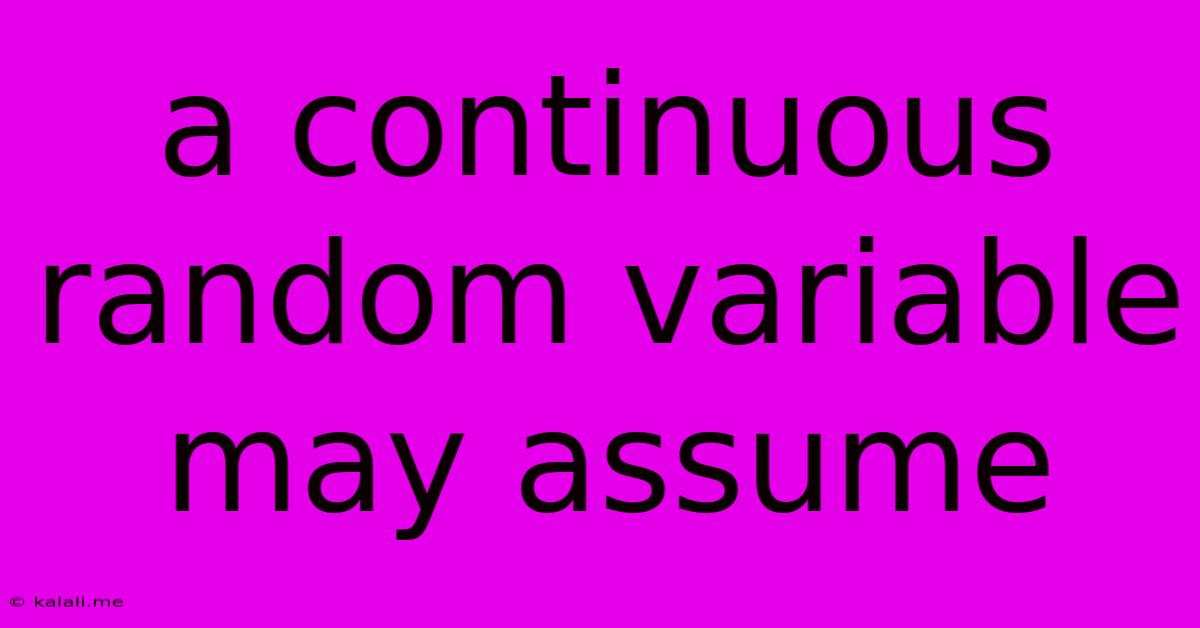A Continuous Random Variable May Assume
Kalali
May 10, 2025 · 3 min read

Table of Contents
A Continuous Random Variable May Assume: Understanding the Possibilities
A continuous random variable is a variable whose value can take on any value within a given range. Unlike discrete random variables which can only take on specific, separate values (like the number of heads in three coin flips), continuous variables can represent measurements like height, weight, temperature, or time. This means understanding what values a continuous random variable may assume requires understanding the concept of probability density functions. This article will delve into the possibilities, clarifying the nuances of this important statistical concept.
What Defines a Continuous Random Variable?
The key characteristic of a continuous random variable is its ability to take on an infinite number of values within a given interval. Think about measuring the height of a person. You could theoretically measure it to an infinite level of precision (e.g., 1.75 meters, 1.753 meters, 1.7532 meters, and so on). This contrasts sharply with a discrete variable, where there are gaps between possible values. For example, you can't have 2.5 children.
The Role of the Probability Density Function (PDF)
Since a continuous random variable can take on infinitely many values, the probability of it taking on any single specific value is actually zero. Instead, we work with probabilities over intervals. This is where the probability density function (PDF) comes in. The PDF, often denoted as f(x), describes the relative likelihood of the random variable taking on a value around x.
The area under the PDF curve over a specific interval gives the probability that the random variable will fall within that interval. This is a crucial distinction: we don't talk about the probability of exactly x, but rather the probability of x falling within a certain range.
What Values Can a Continuous Random Variable Assume?
A continuous random variable can assume any value within its defined range, which is often specified by the support of its probability density function. This range can be:
- Bounded: The variable is restricted to a specific interval, such as [a, b], where 'a' and 'b' are real numbers. For example, the height of a student might be bounded between 1.2 meters and 2.0 meters.
- Unbounded: The variable can take on any value from negative infinity to positive infinity (-∞, +∞). For instance, the temperature in Celsius could theoretically range from extremely cold to extremely hot values.
- Semi-bounded: The variable is bounded on one side but unbounded on the other. For example, the lifespan of a machine may be bounded below by zero but extends indefinitely (0, ∞).
Examples of Continuous Random Variables and Their Possible Values:
- Normal Distribution: This is perhaps the most well-known continuous distribution. It's characterized by its bell-shaped curve and can assume values across the entire real number line (-∞, +∞). Examples include height, weight, and IQ scores.
- Exponential Distribution: This distribution is often used to model the time until an event occurs. It's defined for positive values (0, +∞) and is commonly used in reliability analysis.
- Uniform Distribution: This distribution assigns equal probability to all values within a specific interval [a, b]. Any value within this interval is equally likely.
Understanding the Implications
The fact that a continuous random variable can assume an infinite number of values within its range has significant implications for statistical analysis. We need to use integration techniques (calculus) to calculate probabilities, as opposed to the summation used for discrete variables. This requires a more sophisticated mathematical framework, but it allows us to model and understand a vast array of real-world phenomena.
By grasping the concept of the probability density function and the range of possible values, we can effectively work with and interpret continuous random variables in various applications, from scientific research to financial modeling.
Latest Posts
Latest Posts
-
How Many Cups Is 1 Pound Of Cheese
Jul 12, 2025
-
30 X 30 Is How Many Square Feet
Jul 12, 2025
-
How Much Does A Half Oz Weigh
Jul 12, 2025
-
Calories In An Omelette With 3 Eggs
Jul 12, 2025
-
How Do You Say Great Grandmother In Spanish
Jul 12, 2025
Related Post
Thank you for visiting our website which covers about A Continuous Random Variable May Assume . We hope the information provided has been useful to you. Feel free to contact us if you have any questions or need further assistance. See you next time and don't miss to bookmark.